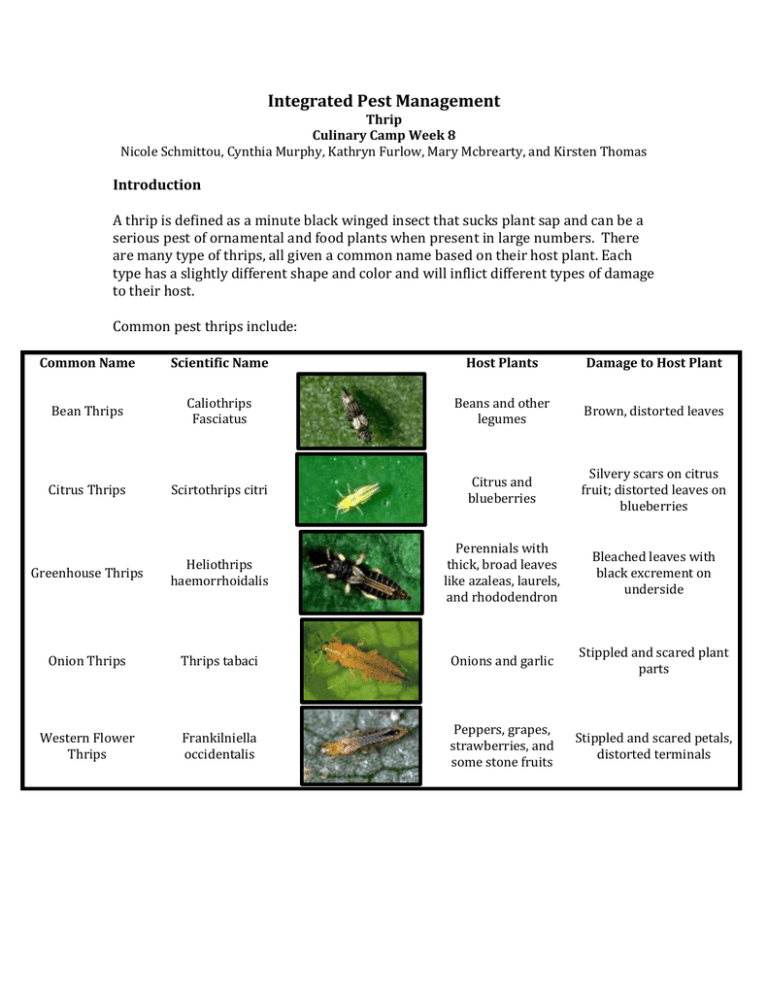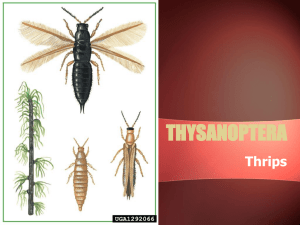Week 8 Thrips
advertisement

Integrated Pest Management Thrip Culinary Camp Week 8 Nicole Schmittou, Cynthia Murphy, Kathryn Furlow, Mary Mcbrearty, and Kirsten Thomas Introduction A thrip is defined as a minute black winged insect that sucks plant sap and can be a serious pest of ornamental and food plants when present in large numbers. There are many type of thrips, all given a common name based on their host plant. Each type has a slightly different shape and color and will inflict different types of damage to their host. Common pest thrips include: Common Name Scientific Name Host Plants Damage to Host Plant Bean Thrips Caliothrips Fasciatus Beans and other legumes Brown, distorted leaves Citrus Thrips Scirtothrips citri Citrus and blueberries Silvery scars on citrus fruit; distorted leaves on blueberries Greenhouse Thrips Heliothrips haemorrhoidalis Perennials with thick, broad leaves like azaleas, laurels, and rhododendron Bleached leaves with black excrement on underside Onion Thrips Thrips tabaci Onions and garlic Stippled and scared plant parts Western Flower Thrips Frankilniella occidentalis Peppers, grapes, strawberries, and some stone fruits Stippled and scared petals, distorted terminals Thrips can damage their host plant through feeding and/or transmitting vector viruses. This damage will impact the fruit, flower, leaves, and shoots of the host plant, and is most detrimental to herbaceous ornamentals and vegetable crops. Thrips can also injure humans, as they are known to bite and have potential for causing respiratory and skin irritation. Management Strategies There are many predators of thrips that can be utilized to manage their population and decrease their damage. Green lacewings, minute pirate bugs, mite, and parasitic wasps are all natural predators. Releasing specific predators based on the specific threatening species of thrip will be the most effective. Minute pirate bugs and green lacewing larvae are predators of citrus trhips Parasitic magaphragma mymaripenne wasps are predators of greenhouse thrips Some physical management techniques include: Use water to knock thrips off from underside of leaves Prune injured/infested plants Use of aluminum foil or reflective mulch as ground cover Remove weeds and grass from host plants to prevent alternate hosts Keep plants well irrigated Organic topical products: Insecticidal soaps made from plant oils and animal plants (best used for small infestations) o Ex. Safer Soap. A quart of ready to use spray treats 1,000 sq. ft. If using concentrate, mix a pint with 6 gallon of water. Apply every 710 days, ideally in the morning and when outside temperature is less than 90°F to prevent wilting. Spinosad, an organic compound occurring in fermented soil that can be used as an insecticide. o Ex. Monterey Garden Insect Spray. Combine 4 Tbsp. concentrate per gallon of water and apply to upper and lower surfaces of foliage. Sources: http://www.oxforddictionaries.com/us/definition/american_english/thrips http://www.ipm.ucdavis.edu/PMG/PESTNOTES/pn7429.html http://www.planetnatural.com/pest-problem-solver/houseplant-pests/thripscontrol/ http://www.omri.org/home http://www.biokids.umich.edu/critters/Thysanoptera/

